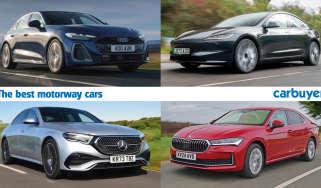Skoda Superb hatchback - MPG, running costs & CO2 (2015-2024)
The Skoda Superb can return almost 80mpg – impressive for such a large car
Even though the Skoda Superb is a large, luxurious car, it shares components with compact, economical models from elsewhere in the VW Group. This means that the Superb shouldn’t cost a lot more to run than other, smaller cars in the Skoda lineup.
Now buyers also have the option of an alternatively fuelled Superb iV, using a similar plug-in hybrid powertrain to the Volkswagen Passat GTE. With a 34-mile electric range and low company-car tax rating, this is especially popular with business drivers.
Skoda Superb MPG & CO2
The Superb offers a 2.0-litre diesel engine with either 148bhp or 197bhp. The 148bhp version can manage 59.3mpg and emits 125g/km of CO2 in SE trim, which means it sits in a middling Benefit-In-Kind (BiK) bracket for company car tax, but is cheap to run for those doing a lot of motorway miles.
Even the 197bhp diesel engine manages up to 52.8mpg in certain trims. Add four-wheel drive and the economy figure suffers, coming in at 48.2mpg.
Many company car buyers will opt for the plug-in hybrid Superb iV, which uses a 1.4-litre petrol engine, electric motor and battery pack for hybrid driving and an electric-only range of up to 34 miles. According to the WLTP testing cycle, this nets around 200mpg, but precise fuel economy will depend entirely on how often you top up the battery pack and how much you need to use the petrol engine. Long motorway journeys will see the petrol engine work harder and fuel consumption rise accordingly, while local journeys may not use any fuel at all. Charging the battery from a 3.6kW wallbox takes 3.5 hours and business users will enjoy a much lower BiK band than the rest of the range, bringing significant cost savings.
Lower-mileage users might be more tempted by one of the petrol-engined Superbs. The least expensive model is the 148bhp 1.5-litre TSI, which manages an official figure of around 47mpg with a manual gearbox – the automatic version will get you up to 45.5mpg. This is largely due to cylinder-deactivation technology, which essentially reduces the size of the engine when full power isn’t needed. The manual and automatic versions produce 136g/km and 141g/km in CO2 emissions respectively.
More reviews
Those interested in performance may find the 2.0-litre TSI-engined car appealing, though it is markedly less economical. There are two versions available, and the less powerful 187bhp engine returns 40.7mpg and produces 158g/km of CO2. The other, with 268bhp, four-wheel-drive and a DSG gearbox, will achieve 33.7mpg with CO2 emissions of 190g/km, resulting in a top-level BiK rating.
It’s worth noting that all the diesel engines require periodic topping up with AdBlue, a fluid automatically injected into the exhaust system which actively reduces exhaust pollutants and helps the car to meet Euro 6 emissions standards.
Insurance group
As with any range of cars with a broad choice of engines, the insurance ratings for the Skoda Superb vary across the range. Most models sit in groups between 19 and 28. The most expensive models to insure will be the most powerful 2.0-litre TSI models, the 268bhp version of which has a group 33 insurance rating in Sportline Plus trim. The most powerful diesel engines are in groups 26-28.
Servicing
Your Skoda Superb servicing intervals can follow either of two regimes. The easiest to understand is the fixed interval plan, where the car is serviced once a year or every 10,000 miles. This is the recommended programme for low-mileage drivers or those who mainly make shorter journeys, or who do a lot of driving in an urban environment where the car is subjected to a lot of repetitive stopping and starting.Skoda offers a service plan to cover your first two services at a cost of just under £300.
The other way to ensure that your car is maintained appropriately is to ask to be set up for variable interval servicing. In this case, sensors on the car monitor the way the car is driven and will self-determine when a visit to the workshop is due, which could be anywhere from 9,000 to 20,000 miles, but services won’t be any longer than two years apart.
This might be worth looking into if you’re mostly on motorways making primarily long journeys at consistent speeds, where the car is less likely to be subjected to the stresses of stop-start driving. For further advice we suggest contacting your Skoda dealership.
Warranty
Skoda offers the same warranty for the Superb as on the rest of the range. It’s a three year/60,000 mile warranty, unlimited in mileage for the first two years but then capped to 60,000 miles in the third. You can extend the standard warranty to last for four years/80,000 miles or 5 years/100,000 miles, but there’s an extra charge of £300 or £630 respectively.
It seems a shame that Skoda, which prides itself on the quality and reliability of its products, doesn’t offer a longer free warranty to compete with certain rivals. Hyundai, for example, offers a five-year/unlimited-mileage warranty as standard.











